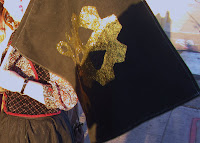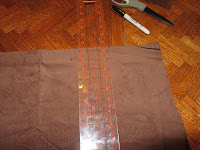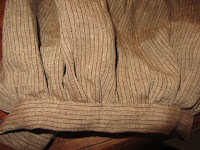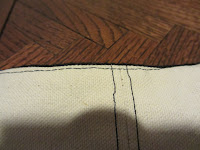 Sometimes a costume doesn't really come to life until we add those last, little touches. For this costume I had a host of accessories in mind but limited time to pull them together. Rather than driving myself mad with several sleepless nights, I decided to experiment with limiting myself to just a few touches and prioritizing them.
Sometimes a costume doesn't really come to life until we add those last, little touches. For this costume I had a host of accessories in mind but limited time to pull them together. Rather than driving myself mad with several sleepless nights, I decided to experiment with limiting myself to just a few touches and prioritizing them.I started with a sheath for my wooden sword. I wanted to have some sort of weapon and in my personal conception, pirates riding around on dirigibles would not use a great many fiery, projectile like weapons. Growing up with a grandfather who was part of the the early aviation scene in the U.S, I heard his retelling of Hindeburg fire that I can imagine only disastrous consequences to fire on a dirigible. So. A sword simulacrum for me!
The sword had the added advantage of being already on hand. I studied Tai Chi sword for a number of y
 ears so I could simple pull out my wooden practice sword and work up a sheath to coordinate with my ensemble. I pulled out some brown felt, and using the sword body for my template, I sketched out a pattern onto the fabric. I tried to account for the curve of the sword body by sketching in some extra room before the curve in the blade.
ears so I could simple pull out my wooden practice sword and work up a sheath to coordinate with my ensemble. I pulled out some brown felt, and using the sword body for my template, I sketched out a pattern onto the fabric. I tried to account for the curve of the sword body by sketching in some extra room before the curve in the blade.Once I had my pieces cut, I took what I planned to be the visible side of the sheath and sketched a design onto it for some more gold-work to match what I had done on my corset. I kept the pattern simple thou
 gh I was tempted to go hog wild. By this point, I was becoming a pro at couching on the gold cord. I cut two short lengths of felt which I wrapped over the bottom of D-rings so that I could hang the sheath from my corset or a belt and then basted these hangers into the seam allowance. I then sewed up the side seams and voila, I had a sheath. (All of my guy friends who have done some sort of historical re-enactment with swords assured me that my sheath was entirely impractical and inaccurate, by the by, but it certainly has flair!)
gh I was tempted to go hog wild. By this point, I was becoming a pro at couching on the gold cord. I cut two short lengths of felt which I wrapped over the bottom of D-rings so that I could hang the sheath from my corset or a belt and then basted these hangers into the seam allowance. I then sewed up the side seams and voila, I had a sheath. (All of my guy friends who have done some sort of historical re-enactment with swords assured me that my sheath was entirely impractical and inaccurate, by the by, but it certainly has flair!)Next step was a shirt. I wanted to make up something with big puffy sleeves but knew that I didn't have time for another garment from scratch. However, I did have a nice, scoop necked t-shirt in white that had a splendid grease stain down the front that never came out. I decided that I could tea dye the shirt and that the grease stain would be quite hidden by the body of the corset.
Tea dying is fun and simple! How often do we get to boil our clothes on the stove? It turns out that the kind of tea one uses can affect the color of the dye bath so I tend to use plain old Lypton's ice tea for my dye bath. It has the advantage of being cheap,
 coming in large quantities and providing a decent brownish color. It antiques whites very nicely. I typically take two bags of the tea, tie them to the handle of a large pot, fill said pot with water, and boil away! Once the water has boiled and the tea has steeped for a wee bit, I throw in the fabric. I tend to turn the heat off at this point and then stir like mad. (Note: make sure to pre-wash before dyeing fabric or clothes. It removes any chemicals or grease and dirt from wear.)
coming in large quantities and providing a decent brownish color. It antiques whites very nicely. I typically take two bags of the tea, tie them to the handle of a large pot, fill said pot with water, and boil away! Once the water has boiled and the tea has steeped for a wee bit, I throw in the fabric. I tend to turn the heat off at this point and then stir like mad. (Note: make sure to pre-wash before dyeing fabric or clothes. It removes any chemicals or grease and dirt from wear.)While I was dying my little shirt, some kind soul started ringing my door bell. Once I had explained, politely, that I was not in fact interested in the product they were selling, and returned to my shirt, I was afraid I had allowed it to steep too long. It was rather darker than I had planned. I threw it into the wash and thankfully, it turned into fairly nice creamy color. For the most part. The results of stepping away from my stirring was that my shirt came out very streaky. Generally not a desirable result, this streakiness was perfect for a pirate living her life around smoke, dust, and grease on a dirigible. In other words, the shirt looked lived in. I loved it. Also, the grease stain on the front was entirely obscured by the tea dye. Sometimes serendipity is awesome.
So now I had a shirt and a sword to go with the pants, corset, spats and hat. What more could a lady ask for? Well... a flag of course! My husband stepped in at this point and g
 allantly assisted me. I had started drafting out a skull and crossbones that hinted at the Steampunk genre. (I was amusing myself mightily by trying out different goggles on my skull when my husband found me.) Dear readers, he rescued you all from my strange humor and provided a wonderful skull and cross bones stencil which he then applied to the flag fabric. I can take credit only for stitching up the raw edges and attaching the flag to a little wooden pole. The true brilliance was all my husband's. I felt quite piratical waving around my flag.
allantly assisted me. I had started drafting out a skull and crossbones that hinted at the Steampunk genre. (I was amusing myself mightily by trying out different goggles on my skull when my husband found me.) Dear readers, he rescued you all from my strange humor and provided a wonderful skull and cross bones stencil which he then applied to the flag fabric. I can take credit only for stitching up the raw edges and attaching the flag to a little wooden pole. The true brilliance was all my husband's. I felt quite piratical waving around my flag.To finish things off, I added a few ready-made accessories. I have a lovely pair of mitts from Clockwork Couture that were a gift. I also pulled out a wonderful necklace that I had picked up earlier at a local shop, Silver Sea Jewelry. I love this place not only because it is local and the prices are amazingly good, but also because it is the business of a dear friend. It is my only piece of jewelry with obvious gears, and I love that they move and mesh. I topped everything off with a flamboyant pair of earrings from the local UNICEF store. Big, brass, and jangly: they were a special find at the shop many
 years ago, and as I recall, they arrived in Tucson from parts unknown in India.
years ago, and as I recall, they arrived in Tucson from parts unknown in India.Last but not least was the bag. Originally, I had planned to make a little pouch that I could hang off a belt or from the bottom of my corset so that my arms and hands would be mostly free. A purse simply did not feel quite right with a piratical ensemble. However, time evaporated very quickly under the weight of all that gold work embellishment. I pulled out a bag I made last year. I am quite fond of my reticule of smashing, as I like to call it, and think it suits the ensemble reasonably well even though it is not the most practical of things for a pirate to carry.
Having fun with a wonderful friend or two or three is, of course, the very best way to finish a costume. I am glad to say
 that I could debute my Steampunk Pirate ensemble by going out on the town with my best girlfriend who wasn't an accessory at all... unless you think in the legal sense. She certainly was willing to get up to any and all hijinks with me. She even incited a few of her own! I won't speak for her experience making a costume but I will say that she looked positively stunning. She turned more than a few heads as we paraded around in downtown Tucson, bringing our own brand of pirate tomfoolery with us. I would not have enjoyed my costume half so much or had even a fraction of the fun without her there to wave our flag, accost strangers and general behave as the amazing woman she is. What a delightful end to a fun project!
that I could debute my Steampunk Pirate ensemble by going out on the town with my best girlfriend who wasn't an accessory at all... unless you think in the legal sense. She certainly was willing to get up to any and all hijinks with me. She even incited a few of her own! I won't speak for her experience making a costume but I will say that she looked positively stunning. She turned more than a few heads as we paraded around in downtown Tucson, bringing our own brand of pirate tomfoolery with us. I would not have enjoyed my costume half so much or had even a fraction of the fun without her there to wave our flag, accost strangers and general behave as the amazing woman she is. What a delightful end to a fun project!~La Cucitrice












































